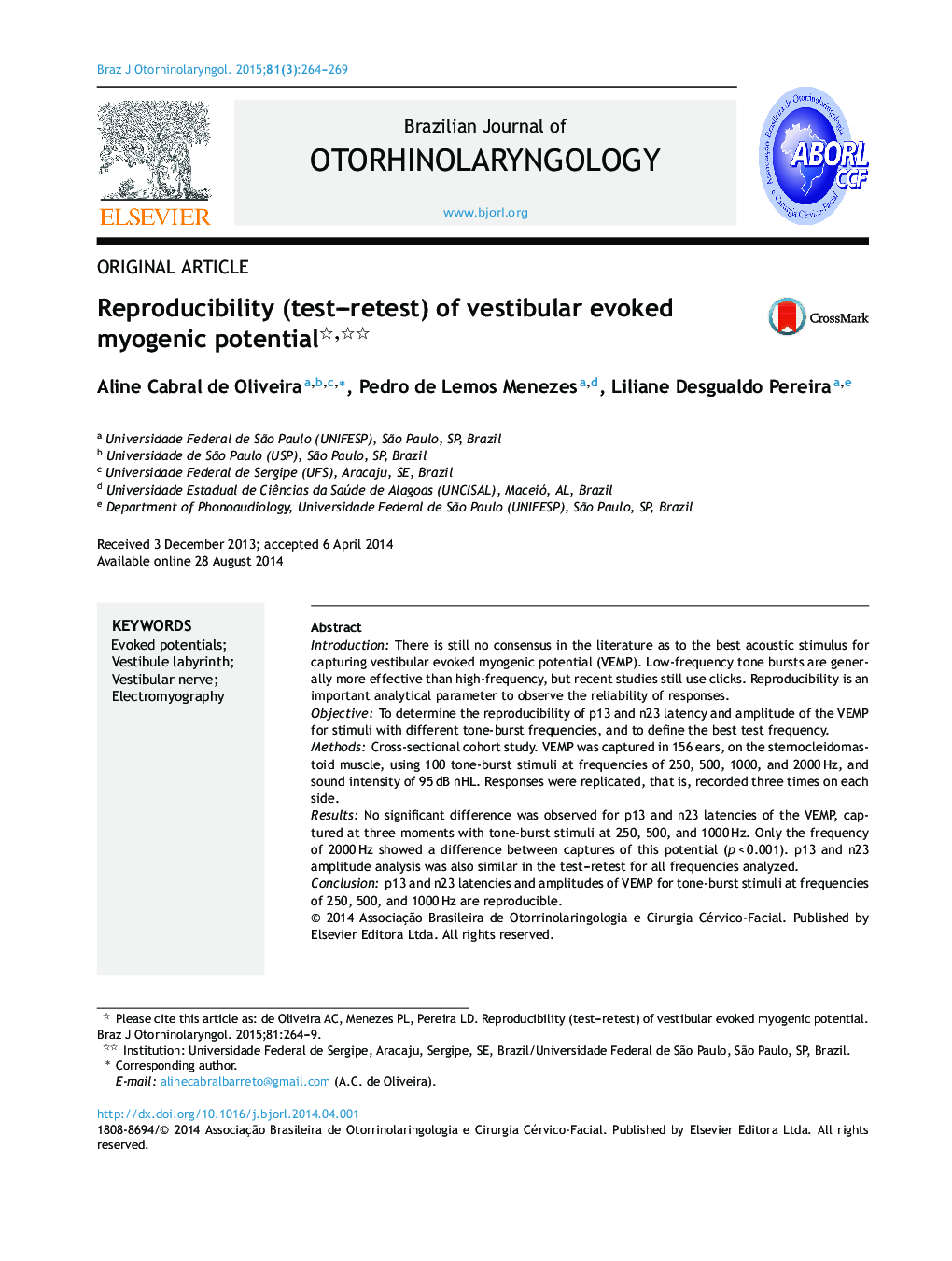| کد مقاله | کد نشریه | سال انتشار | مقاله انگلیسی | نسخه تمام متن |
|---|---|---|---|---|
| 4106235 | 1605367 | 2015 | 6 صفحه PDF | دانلود رایگان |
IntroductionThere is still no consensus in the literature as to the best acoustic stimulus for capturing vestibular evoked myogenic potential (VEMP). Low-frequency tone bursts are generally more effective than high-frequency, but recent studies still use clicks. Reproducibility is an important analytical parameter to observe the reliability of responses.ObjectiveTo determine the reproducibility of p13 and n23 latency and amplitude of the VEMP for stimuli with different tone-burst frequencies, and to define the best test frequency.MethodsCross-sectional cohort study. VEMP was captured in 156 ears, on the sternocleidomastoid muscle, using 100 tone-burst stimuli at frequencies of 250, 500, 1000, and 2000 Hz, and sound intensity of 95 dB nHL. Responses were replicated, that is, recorded three times on each side.ResultsNo significant difference was observed for p13 and n23 latencies of the VEMP, captured at three moments with tone-burst stimuli at 250, 500, and 1000 Hz. Only the frequency of 2000 Hz showed a difference between captures of this potential (p < 0.001). p13 and n23 amplitude analysis was also similar in the test–retest for all frequencies analyzed.Conclusionp13 and n23 latencies and amplitudes of VEMP for tone-burst stimuli at frequencies of 250, 500, and 1000 Hz are reproducible.
ResumoIntroduçãoAinda não existe consenso quanto ao melhor estímulo acústico utilizado para a captação do potencial evocado miogênico vestibular (PEMV). Respostas amplas são observadas para estímulos de baixa frequência, porém estudos recentes ainda utilizam cliques. A reprodutibilidade dos traçados é um importante parâmetro de análise para observar a confiabilidade das respostas.ObjetivoVerificar a reprodutibilidade dos parâmetros “latência e amplitude das ondas p13 e n23” do PEMV para estímulos com diferentes frequências de estímulos do tipo tone burst, e definir a melhor frequência de teste.MétodoEstudo de coorte-transversal. Captou-se PEMV em 156 orelhas, no músculo esternocleidomastóideo, com 100 estímulos do tipo tone burst nas frequências de 250, 500, 1000 e 2000 Hz e nível sonoro 95 dB NAn, registrados três vezes de cada lado.ResultadosForam constatadas similaridades para latências de p13 e n23 do potencial estudado nos três momentos com estímulos tone burst em 250, 500, 1000 Hz, e diferenças entre as captações desse potencial (P < 0.001) para a frequência de 2000 Hz. A análise da amplitude de p13 e n23 se mostrou semelhante, no teste-reteste, para todas as frequências analisadas.ConclusãoExiste reprodutibilidade das latências e amplitudes de p13 e n23 do PEMV para estímulos tone burst nas frequências de 250, 500 e 1000 Hz.
Journal: Brazilian Journal of Otorhinolaryngology - Volume 81, Issue 3, May–June 2015, Pages 264–269
